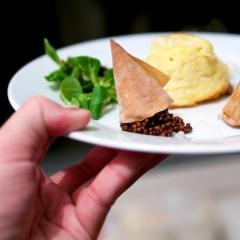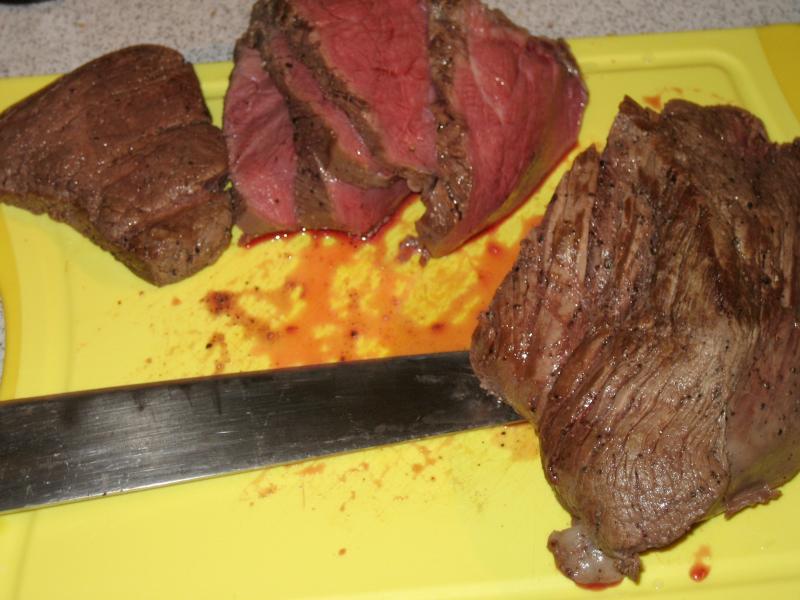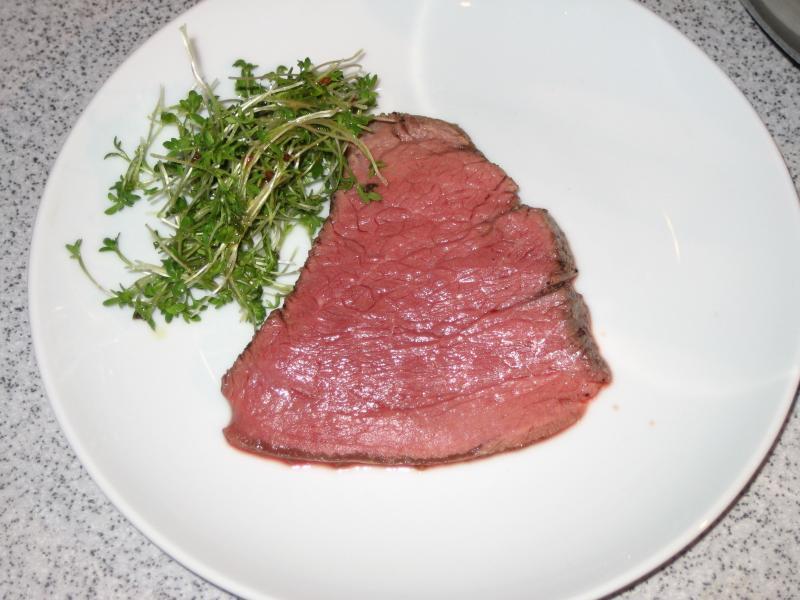-
Posts
346 -
Joined
-
Last visited
Content Type
Profiles
Forums
Store
Help Articles
Everything posted by pep.
-
Sure, professional chefs may know about her, but she is a far cry from a public figure and not very controversial. never said she was. Ah, OK. Maybe the scope of this thread is too large to answer. Even if we could eliminate the US bias a bit, I doubt which "food figure" is known and controversial in, say, China or India. Most of people put forward so far seem to TV celebrities in the US that most people from the street would know and have an opinion on. Even with satellite TV this is not the case for much of the rest of the world. I could probably name some TV cooks from Austria that would get the same kind of reaction over here (you love 'em or you hate 'em), but you wouldn't have heard of those guys. There are very few people that will get this kind of awareness globally.
-
Sure, professional chefs may know about her, but she is a far cry from a public figure and not very controversial. Addendum: What I do find funny, though, is people from the US declaring who is well known outside the US ...
-
Reporting back from the chuck: Cooked at 54.5°C for about 27 hours (wasn't home when the 24 hours ran out). Chilled in ice bath and reheated on Sunday. Color and texture while slicing were nice (I cut away the fat before bagging and seared with the torch after cooking), but the meat was a bit more chewy than I would have liked. Decidely NOT like the tenderloin we had three weeks ago. So next time I'll leave this cut in for 48 hours. I'll also have to report to my butcher, once I told him what I intended to do, he was very keen on hearing about the results ;-) Also next time I'll have to be lighter on the salt. I changed my cookign salt brand recently and the new one (a kind of gray sea salt) has much larger crystals than what I'm used to. I should have ground the salt in the mortar before rubbing the meat. My guests disagreed (but maybe out of politeness), but the saltiness detracted from the beef flavor. It wasn't inedible or anything, but not a stellar performance either.
-
Some people don't like his TV show. But I wouldn't have nominated him, I just tried to comment on some of the names that have come up in the discussion so far.
-
The influence is massive: There is is virtually nowhere you can go, without encountering the US influence on food. It may not be a good influence, but it is ubiquitous. In terms of generating actual controversy, I'm thinking Sandra Lee, or Rachael Ray: It seems impossible to mention either one (to anyone who's heard of them) without people taking sides and shouting. I admit that I cannot recognize either, and don't care, but every time they're being discussed, you get significant partisan reactions. This isn't to say that either one has the least significance, in actual culinary terms. I've got no idea if they are better known in English speaking countries, but I assure you that no-one in Austria or Germany has heard of either Sandra Lee or Rachel Ray. Due to a debate on eGullet, I've seen the Sandra Lee video with the Kwanza cake, but I still haven't got a clue what Rachel Ray does. I would count Alice Waters as practically unknown as well. Julia Child has gotten some reception since the 2009 movie, before that I doubt that anyone knew who she was. To the best of my knowledge, there is no German version of Mastering the Art of French Cooking. Ferran Adrià and Jamie Oliver on the other hand are well known here (even by people who are not deep in the "food world", though Adrià may be known to them as "the Spanish guy with the weird foams and stuff" ;-).
-
Yes, a bit of bite would be better. Actually, the shorter cooking time suits me fine. That means I will have the sous-vide rig available for other stuff on sunday and I will just need to bring the beef up to temp for serving. Originally, I put them in at 55.0°C, but I reduced the temperature setting by a half degree after I read your post. For bagging, I split the beef into two parts as I didn't trust my cooking vessel (a 9.0l IKEA stock pot) with the larger bag. I've ordered a 27.5l bath, but that's not arrived yet. I salted and spiced both pieces (Tasmanian pepper, some black pepper, a sprinkling of crushed mustard seeds and juniper berries) before bagging them. We'll see how it works out. I've read that browning before putting the meat into the bag doesn't give the nice flavor (although it worked fine with my improvised sous-vide attempt a few weeks ago). But I trimmed the fat (about 200g) and what's left should melt/get crisped with the torch.
-
So 24 hours is enough? As for the fat, I intend to brown it with a blowtorch before serving, shouldn't that be enough to render it somewhat? Greetings, Peter
-
So now that I have my a Polyscience immersion circulator, I'm looking for some tips how to best use it. I've got 1.4 kg of "tough" beef (a cut called "Rieddeckel", which would be a part of what you call chuck, viz. https://ssl.wiesbauer-gourmet.at/wissenswertes/fleisch/fleischkunde/rind_aussen/index.php?ID=4996). I'd like to serve it on Sunday, so I've only got around 32 hours to prepare it. Should I brine it for an hour or two? Give it more than 56°C? Will 24 hours be enough or should I aim to get it in for most of the 32 hours? I've also got some asparagus which I'd like prepare sous-vide, but I could do that conventionally if the beef needs the time.
-
Since last week, I'm a proud owner of a Polyscience Sous Vide Professional. Following Pedro's recommendations in Sous Vide Wiki, I checked various temperatures with my ETI Thermapen (and an additional – uncalibrated – ETI digital thermometer): The temperature reported by the Sous Vide Professional was consistently 0.5°C higher than that measured by the ETI thermometers. Should be no big deal, I thought, the Sous Vide Professional has an "offset calibration" feature to factor in a temperature offset of ±3.0°C. Unfortunately, it wasn't as simple as that. While the manual describes the feature, it is out of date. To prevent accidental changing of the offset, a special power-off/power-on sequence has to be followed before the setting becomes active. Polyscience provided a bilingual (English/French) loose-page addendum to the manual describing the necessary steps. I followed them, but I still couldn't set offset. After trying every possible interpretation of the described steps, I mailed Polyscience. They quickly replied and after some back-and-forth, it was determined that an error had crept into the addendum: instead of the power button, you have to press the menu button while connecting the unit to power. Here is the corrected sequence: Disconnect power cord Plug power cord back in while pressing the menu button Press menu button repeatedly until "offset calibration" is visible Change offset using up and down buttons Press menu button again or wait 10 seconds until the device shows the current and set temperatures again
-
If anyone is interested, I have several of Ewald Plachutta's books (Die gute Küche I + II, Kochschule) and can translate the recipe if necessary. The granuled bouillon could be correct, I was similarly stymied when I reread one of the recipes recently. It seems that these were adapted for home cooks (but the recipes are quite good nonetheless). If you want a truly classical recipe for Tafelspitz, you'd have to look into Franz Maier-Bruck "Klassische Österreichische Küche" (vormals "Das große Sacher-Kochbuch"). It's a bit old-ish (1975), and I think some procedures where rather old-fashioned even then, but this is the authoritative book an classical Austrian cuisine. Anyway, I have that one available, too.
-
Na, it's W-S blocking of visitors from that country. I don't see why it should be illegal, but it sure is dumb. And even if there was a lot of credit card fraud in some country, it wouldn't hurt W-S because they don't deliver outside of the US anyway.
-
After some googling, I have to retract my statement. Apparently, W-S and related companies are blocking some countries' access to their website. No one seems to have a real clue as to why, but the official statement indicates that it has got something to do with credit card fraud. Why some countries seem to be on their block list is beyond me, as they do not ship to non-US addresses anyway.
-
I've got no problem displaying the site. From the error message you report, it seems more likely that you are using a proxy of some kind that (probably erroneously) prohibits access to the site. Greetings, Peter
-
So here a the promised pics. Part of the tenderloin on the cutting board (not a good color combo on the photo ;-): The plated dish: A slice of roastbeef with a light "salad" of garden cress with olive oil (I wanted to use lime-infused olive oil to give it some acidity, but forgot in the hurry). In real life, the meat was slightly more red than it appears on my monitor.
-
Dinner's over, all the guests have left (we met for cocktails at 15:30 local time to be "parent friendly", the actual meal started around 17:00). The beef turned out very well, using my crude low temperature/pseudo sous-vide method. I'll post pictures tomorrow. Obviously timing was critical, but as the water most likely did not actually reach 75 degrees (even though I filled the vessel with near-boiling water, the cold meat must have dropped the temperature much faster than the oven could heat it up), color and texture where great and very uniform. The meat was roughly cylindrical with a diameter of approximately 8 cm (I didn't have a caliper so it could be 5 mm up or down). Since I "navigated" using my old analogue meat thermometer (which I will replace soon, but supermarkets do not carry digital thermometers here, inexpensive or otherwise), I can't say what the cooking time was exactly. It was more like "OK, still a few degrees missing, check again in 10 minutes" thing, but I guess total time was around 1 hour 40 minutes (plus 5 minutes resting time). Next time, I'll have my new Polyscience circulator, so the whole process should be much easier. Anyway, thanks for the link to Nathan's table (even if I could not directly use them) and for the general support. PS @blackp: Regarding Beef Wellington, why use liverwurst? Maybe you have got better liverwurst, but I'd rather make the duxelles for Wellington without any liver than use a pork or veal sausage. But then again I have a somewhat irrational dislike for commercial forcemeat sausages – probably some repressed childhood trauma ;-) I've never used actual pâté de foie in my Wellingtons, but when I substitute for this ingredient, I use chicken liver sauteed with some shallots and white wine (blended of course).
-
If you reread my original post carefully, you will notice that I have purchased an immersion circulator already, it just hasn't been delivered in time. Also, the roastbeef is not the main course and I'd like to use low temperature cooking as to not overdo it (so we omit the sous-vide label you seem to object to). Unfortunately, I haven't seen any cooking time tables for cooking at a higher temp then the target temp (but still low) anywhere.
-
Unfortunately, keeping the oven door open is not an option. The electrical oven is small standalone microwave/grill/convection combi gadget that stops if you open the flap. My "real" oven is a 70s or 80s gas stove monstrosity which can't be set low enough (and the stove knobs melt if you open the door long enough - I've already tried that for meringues once or twice ;-). But yes, I could use the thermometer in the water to get a feel for the real temp in the oven. Maybe the setting "75 degrees" is actually low enough. But still, even with 60 degrees, I couldn't use the time tables for thickness, so I'll have to measure core temp at some point...
-
For a complete change in topic (and my first post): I've got 12 guests arriving in a few hours for a six-course meal and my internet-ordered immersion circulator hasn't arrived in time. One of the dishes is supposed to be a kind of roastbeef sous-vide and so 1,5 kg of beef tenderloin (I hope that's the right word for the cut, in Austria we call it Lungenbraten/Filet) thawing in the fridge. My current plan is to sear it on all sides, rub it with salt and pepper and vacuum seal it with a small amount of beef stock. Then I'd fill a Pyrex bowl with hot water (barely not boiling) and put it into the oven at nominally 75 degrees centigrade. After an hour or so, I'd check the core temperature (unfortunately, I don't have an accurate thermometer, just an analogue bi-metal one). If it shows slightly over 50 degrees core temp, I know from experience that with resting, I'll get a nice red medium rare. Any objections? Better ideas? Cooking times? I've got Under Pressure and Sous-vide for the Home Cook, but as far as I have ssen, both assume you cook at the desired core temp + 0,5, which I can't do (no accurate temp and the oven can only be set in 25 degree steps, starting at 50). Greetings, Peter




